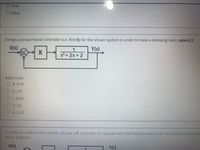
Introductory Circuit Analysis (13th Edition)
13th Edition
ISBN: 9780133923605
Author: Robert L. Boylestad
Publisher: PEARSON
expand_more
expand_more
format_list_bulleted
Question

Transcribed Image Text:O True
O False
Design a proportional controller (i.e. find K) for the shown system in order to have a damping ratio: zeta=0.2
U(s)
1
Y(s)
K
s?+ 2s + 2
Select one:
a. 4.25
Ob. 2.0
C. 8.25
Od. 23
Oe. 2.25
In order to stabilize the system, we use a P controller in cascade with the feed-forward chain as shown in the follo
block diagram:
U(s)
Y(s)
Expert Solution
This question has been solved!
Explore an expertly crafted, step-by-step solution for a thorough understanding of key concepts.
Step by stepSolved in 2 steps

Knowledge Booster
Learn more about
Need a deep-dive on the concept behind this application? Look no further. Learn more about this topic, electrical-engineering and related others by exploring similar questions and additional content below.Similar questions
- Please assist with this practice problem 1 c,d,e with details on how to do it. Thank you.arrow_forward6) In the circuit below, the constant-amplitude voltage generator delivers four times more current at very low frequencies than it does at very high frequencies. If R1=100 N, find the resistance R2. (HINT: Consider how an inductor and a capacitor behave at high and low frequencies.) R1 V C R2arrow_forwardCharging Capacitor: For a charging capacitor the Kirchoff's Loop Rule gives R E – IR C ww C In this case the current is entering the positive plate so I = dQ/dt = CdAVc/dt and we get dVc E – RC - Vc = 0 dt The solution to the differential equation is V.(t) = E (1 – e-t/(RC)) (charging capacitor) Notice that V.(0) = 0 and V.(0) = E as we expect for a charging capacitor. 5. You can easily find the time constant if you are given a graph of voltage across a charging capacitor as a function of time. Whent = RC, the voltage across the capacitor is V.(t = RC) = E(1 – e-1) × 0.63 E. Therefore the time constant is just how long it takes for AV(t) to reach 63% of the EMF. The graph shows the voltage across a charging capacitor as a function of time. The resistance of the circuit is 7.5 kN. а. Determine the capacitance of the capacitor. 10 8 60 40 time (ms) 20 80 100 b. What is the current at t = 10 ms? Hint: the easiest way to do this is to use the loop rule. (volts) 4.arrow_forward
Recommended textbooks for you
 Introductory Circuit Analysis (13th Edition)Electrical EngineeringISBN:9780133923605Author:Robert L. BoylestadPublisher:PEARSON
Introductory Circuit Analysis (13th Edition)Electrical EngineeringISBN:9780133923605Author:Robert L. BoylestadPublisher:PEARSON Delmar's Standard Textbook Of ElectricityElectrical EngineeringISBN:9781337900348Author:Stephen L. HermanPublisher:Cengage Learning
Delmar's Standard Textbook Of ElectricityElectrical EngineeringISBN:9781337900348Author:Stephen L. HermanPublisher:Cengage Learning Programmable Logic ControllersElectrical EngineeringISBN:9780073373843Author:Frank D. PetruzellaPublisher:McGraw-Hill Education
Programmable Logic ControllersElectrical EngineeringISBN:9780073373843Author:Frank D. PetruzellaPublisher:McGraw-Hill Education Fundamentals of Electric CircuitsElectrical EngineeringISBN:9780078028229Author:Charles K Alexander, Matthew SadikuPublisher:McGraw-Hill Education
Fundamentals of Electric CircuitsElectrical EngineeringISBN:9780078028229Author:Charles K Alexander, Matthew SadikuPublisher:McGraw-Hill Education Electric Circuits. (11th Edition)Electrical EngineeringISBN:9780134746968Author:James W. Nilsson, Susan RiedelPublisher:PEARSON
Electric Circuits. (11th Edition)Electrical EngineeringISBN:9780134746968Author:James W. Nilsson, Susan RiedelPublisher:PEARSON Engineering ElectromagneticsElectrical EngineeringISBN:9780078028151Author:Hayt, William H. (william Hart), Jr, BUCK, John A.Publisher:Mcgraw-hill Education,
Engineering ElectromagneticsElectrical EngineeringISBN:9780078028151Author:Hayt, William H. (william Hart), Jr, BUCK, John A.Publisher:Mcgraw-hill Education,

Introductory Circuit Analysis (13th Edition)
Electrical Engineering
ISBN:9780133923605
Author:Robert L. Boylestad
Publisher:PEARSON

Delmar's Standard Textbook Of Electricity
Electrical Engineering
ISBN:9781337900348
Author:Stephen L. Herman
Publisher:Cengage Learning

Programmable Logic Controllers
Electrical Engineering
ISBN:9780073373843
Author:Frank D. Petruzella
Publisher:McGraw-Hill Education

Fundamentals of Electric Circuits
Electrical Engineering
ISBN:9780078028229
Author:Charles K Alexander, Matthew Sadiku
Publisher:McGraw-Hill Education

Electric Circuits. (11th Edition)
Electrical Engineering
ISBN:9780134746968
Author:James W. Nilsson, Susan Riedel
Publisher:PEARSON

Engineering Electromagnetics
Electrical Engineering
ISBN:9780078028151
Author:Hayt, William H. (william Hart), Jr, BUCK, John A.
Publisher:Mcgraw-hill Education,